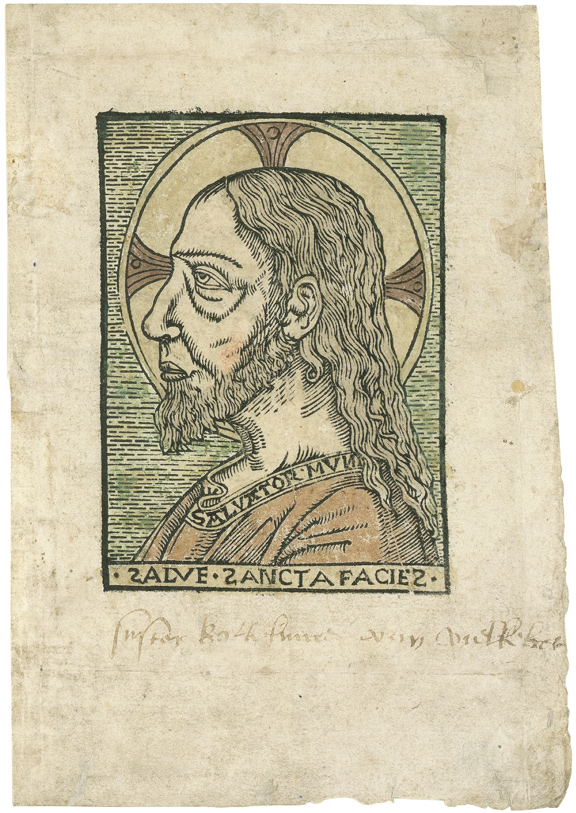Loading the page ...
German School
circa 1500
Salve Sancta Facies; Bust-length Portrait of Christ in Left Profile. Woodcut with contemporary colouration. 9.1 x 6.2 cm. Contemporary lettering in pen and brown ink: “suster Kathrinne van putk be...”. Unrecorded.
The present rare woodcut is one in a long tradition of profile portraits of the Redeemer which were in circulation during the second half of the 15th and the whole of the 16th century in Italy and north of the Alps. In the 15th century, before this type of picture was introduced to the graphic arts and painting, bronze medallions with a profile portrait of Christ were distributed by Pisanello and his circle. The earliest known prototype comes from the hand of Matteo de’ Pasti and was made between 1441 and 1450 (Florence, Museo Nazionale del Bargello). It is likely that between 1492 and 1500 a series of Italian bronze medallions were circulating whose iconography was to serve as a model for countless artists all over Europe, among them the anonymous master of our woodcut. The prototype of this medallion is still the subject of scholarly debate today. The Berlin Sculpture Collection possesses a version with an inscription on the reverse, which mentions that it is a copy of the “true likeness” of Christ. Tradition has it that the portrait was engraved on an emerald and given as a present by the Ottoman Sultan Bayezid II (1447–1512) to Pope Innocent VIII so that the latter would continue to keep Bayezid’s brother and rival a prisoner in the Vatican. In keeping with mediaeval custom this is clearly an example of myth-making, as this version is not supported by the historical facts and the emerald in question has not survived.
In comparison to earlier Italian bronze medallions the physiognomy of this head of Christ exhibits highly individual, Nordic characteristics. The receding forehead, strong nose and full lips as well as the short beard and long hair falling onto the shoulders suggest a prototype outside of Italy. One thesis advanced by earlier researchers was that this type of image was of Flemish origin, being connected with a painting in Berlin that today is attributed to the Bruges Master of 1499 (see G. F. Hill, The Medallic Portraits of Christ, Oxford, 1920, pp. 36–40). It would take us too far afield to deal with all the attempts at mystification in which this original version is shrouded. We may, however, mention one more example. The detailed legend on Hans Burgkmair’s woodcut of 1512 with the head of Christ in profile (Bartsch 20, Hollstein 52) refers to the famous letter of the Roman Proconsul Lentulius, which contains an exact description of the terrestrial appearance of Christ. This letter probably arose at the end of the 13th or the beginning of the 14th century in a monastic context and was widely disseminated during the 15th century.
However unclear the origin of the tradition of pictures showing the true face of Christ may be, their extraordinary familiarity is an undisputed fact. Not only Hans Burgkmair, but also Melchior Lorch, Hans Holbein the Elder and a large number of Northern European and Italian artists created further versions in painted, drawn or printed form around 1500, thus documenting the great popularity of this theme.
